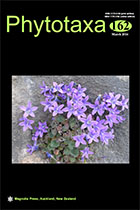Abstract
The taxonomy of subcosmopolitan Urtica dioica L. s.l. is problematic. Recent floras recognize Urtica dioica as a subcosmopolitan species ranging throughout the entire holarctic region and also South Africa and New Zealand. Numerous infraspecific taxa have been proposed, especially in western Eurasia. There is only weak character differentiation, with floral and fruit morphology largely uniform, details of leaf morphology and indumentum are therefore primarily used for species delimitation, together with some characters of gender distribution and growth habit. The present study addresses the enigmatic relationships of the infraspecific taxa in Urtica dioica with a special emphasis on the monoecious, American representatives of Urtica dioica s.l. The study is based on extensive field and herbarium studies, molecular data and the experimental cultivation of all relevant forms. Infraspecific taxa currently assigned to U. dioica are retrieved mainly on two separate clades, one comprising the predominantly polygamous western Eurasian and African taxa (all subspecies and varieties sampled), the other comprising the monoecious American taxa. Monoecious American representatives of “Urtica dioica” and closely allied taxa (U. aquatica, U. mollis) are retrieved as a monophyletic group sister to a clade with East Asian and Australasian species, this clade is then retrieved as sister to the western and central Eurasian and African taxa of U. dioica. We therefore advocate the removal of the American representatives of this group from Urtica dioica and their placement as infraspecific taxa under Urtica gracilis. The following new names are consequently proposed: Urtica gracilis subsp. gracilis (for Urtica dioica subsp. gracilis), Urtica gracilis subsp. holosericea, comb. nov. (for Urtica dioica subsp. holosericea), Urtica gracilis subsp. aquatica, comb. & stat. nov. (for Urtica aquatica), Urtica gracilis subsp. mollis, comb. & stat. nov. (for Urtica mollis). Additionally, we describe a new subspecies from Peru under the name Urtica gracilis subsp. incaica. The literature report of Urtica gracilis (dioica subsp. gracilis) as an introduced weed in New Zealand is shown to be erroneous – the corresponding specimens belong to Australian Urtica incisa. Based on gross morphology close affinities have been proposed between a range of Australasian, Asian, North American and European infraspecific taxa, all of these can be shown to be erroneous.

